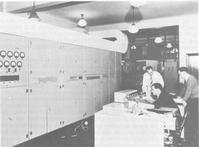


Chapter 8
I Part 1: Communications
II Epilogue
III Part 2: Early Australian Computers And Computing
i Instruments and calculators
ii The transition to the computer, 1945 to 1951
iii The first computers, 1951 to 1956
iv Concentration on large-scale systems, 1958 to 1963
v Software and microelectronics, after 1965
vi Industry, education and the computing fraternity
IV Acknowledgements
References
Index
Search
Help
Contact us

The first computers, 1951 to 1956 (continued)
The fourth machine of this period, the WREDAC, was installed at WRE, Salisbury, SA. Ovenstone had returned to WRE and became involved in problems of processing data recorded during missile flight trials. The massive amounts of computation which were then being carried out by hand by a large staff clearly required automating. Ovenstone, using his Mk 1 and EDSAC experience, pioneered a scheme for integrated automatic handling of telemetry, radio-doppler and radar data recorded at the range on magnetic tape in analogue form and with ground sited flight data. These range data were digitised and processed numerically by a commercially manufactured (but somewhat modified) computer, an Elliott 401. This operated serially, using a relatively small store of 512 34-bit words, held in nickel magnetostrictive delay lines, together with 16,384 words held on synchronous magnetic disc and with magnetic tape drives for large volume data and paper tapes for input and output data. Magnetic taped output was displayed on facsimile machines attached to a special output converter This system set the pattern of range data processing for the next 25 years or so. The WREDAC was delivered in October 1955 and began its formal operation handling range data in September 1956. It was replaced by magnetic tape based IBM 7090/1401 combination in 1962. Ovenstone also pioneered the use of WREDAC for processing WRE's administrative data. This led to his later ideas and plans for a totally automated administrative information system which was to have major effect in the Department of Defence and to the wide acceptance of computer systems in Commonwealth Government Departments in Canberra.All four of these machines were based upon the vacuum tube technology of a large radio industry built up during the 1930s. Typically, the tube count was in the range 800 to 2,000 and heat dissipation was from 10 to 30 kW. All required blown air-cooling. This period ended with the holding, mainly at Ovenstone's instigation, of the second Conference on Computing and Data Processing at WRE Salisbury, on 3 to 8 June 1957. It was attended by 200 people, including a number of prominent UK workers in computing. Fifty papers were presented in three concurrent streams dealing with programming and mathematics, engineering and business applications. From the last of these it was clear that the computer manufacturers were beginning significant marketing operations in Australia.
The last major analogue device of Australian origin, a simulator called the AGWAC (Keats, R. W., 1957), was reported at the Conference, where both it and the WREDAC system were demonstrated. This period also saw the transition from vacuum tube to fully solid state technology as the surface barrier junction transistor, capable of sufficiently high speed, became available. The first Australian fully solid state machine was a digital version of the differential analyser, based upon the vacuum tube Bendix D-12, designed and built by M. W. Allen at the SMI, and funded by Sir Adolph Basser and the Snowy Mountains Hydroelectric Authority (SMHA). Design started in 1955 and the machine, which now was of office desk size, was formally named the ADA by Sir Adolph at Newcastle, NSW, on 11 March 1958 (Allen, M. W., 1957). This was to be the last small special purpose system and all attention thereafter concentrated upon general purpose systems. In retrospect, this move away from small special purpose devices was unfortunate. The design techniques and packaging developed by Allen for the ADA were to set the style for a number of later projects.

Organisations in Australian Science at Work - Snowy Mountains Hydroelectric Authority (S.M.H.A.); Weapons Research Establishment (W.R.E.)
People in Bright Sparcs - Allen, M. W.; Basser, Sir Adolph; Keats, R. W.; Ovenstone, John Allen; Pearcey, T
 |
Australian Academy of Technological Sciences and Engineering |  |
© 1988 Print Edition page 620, Online Edition 2000
Published by Australian Science and Technology Heritage Centre, using the Web Academic Resource Publisher
http://www.austehc.unimelb.edu.au/tia/591.html